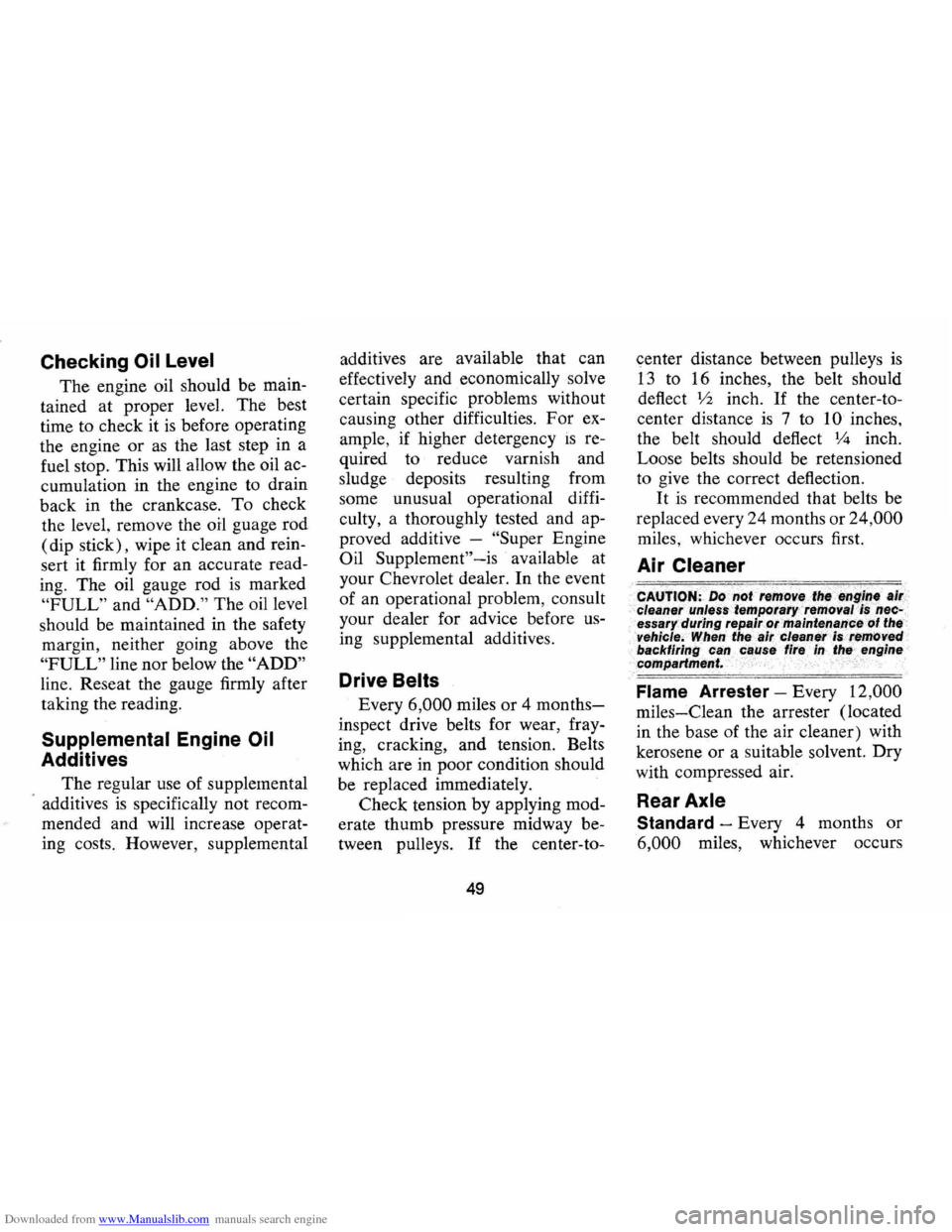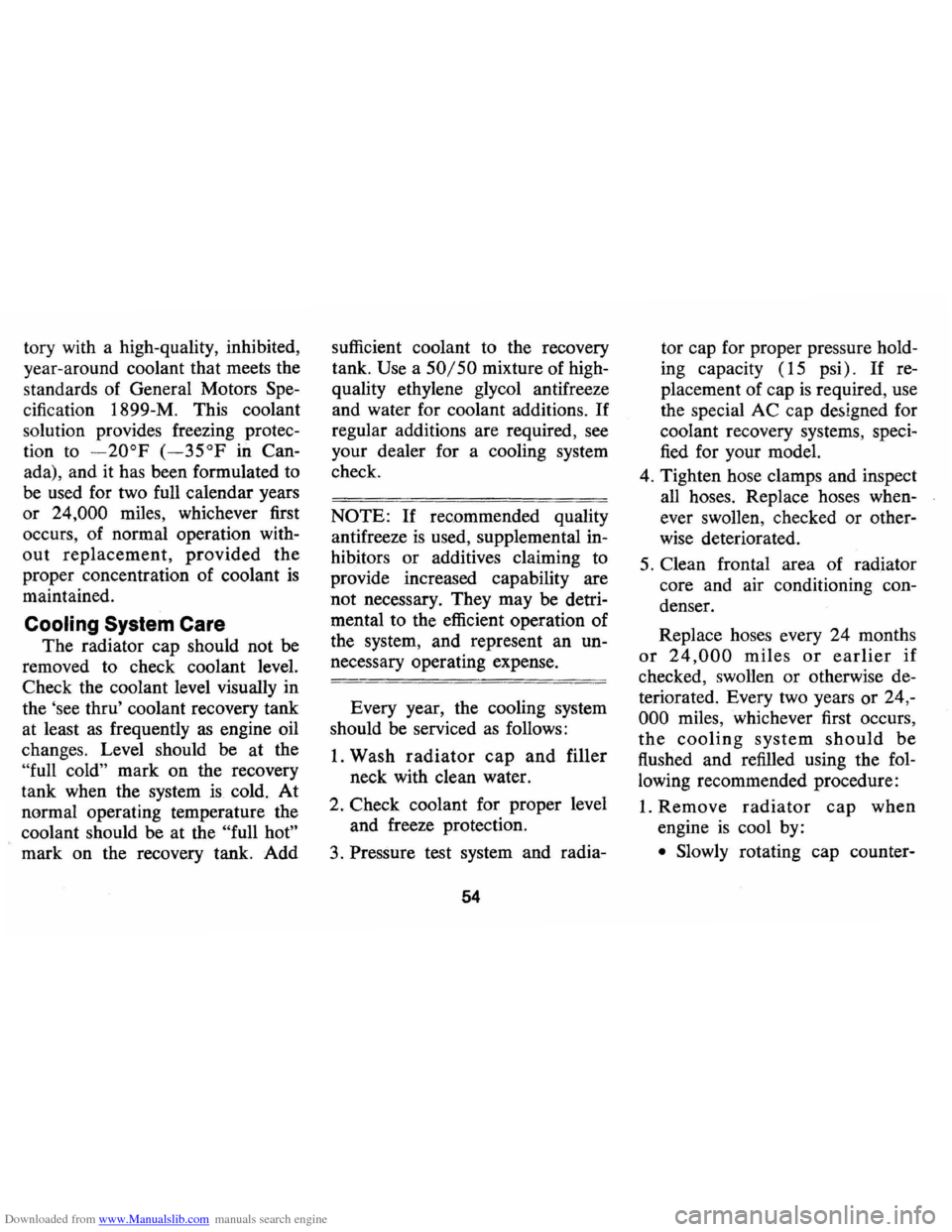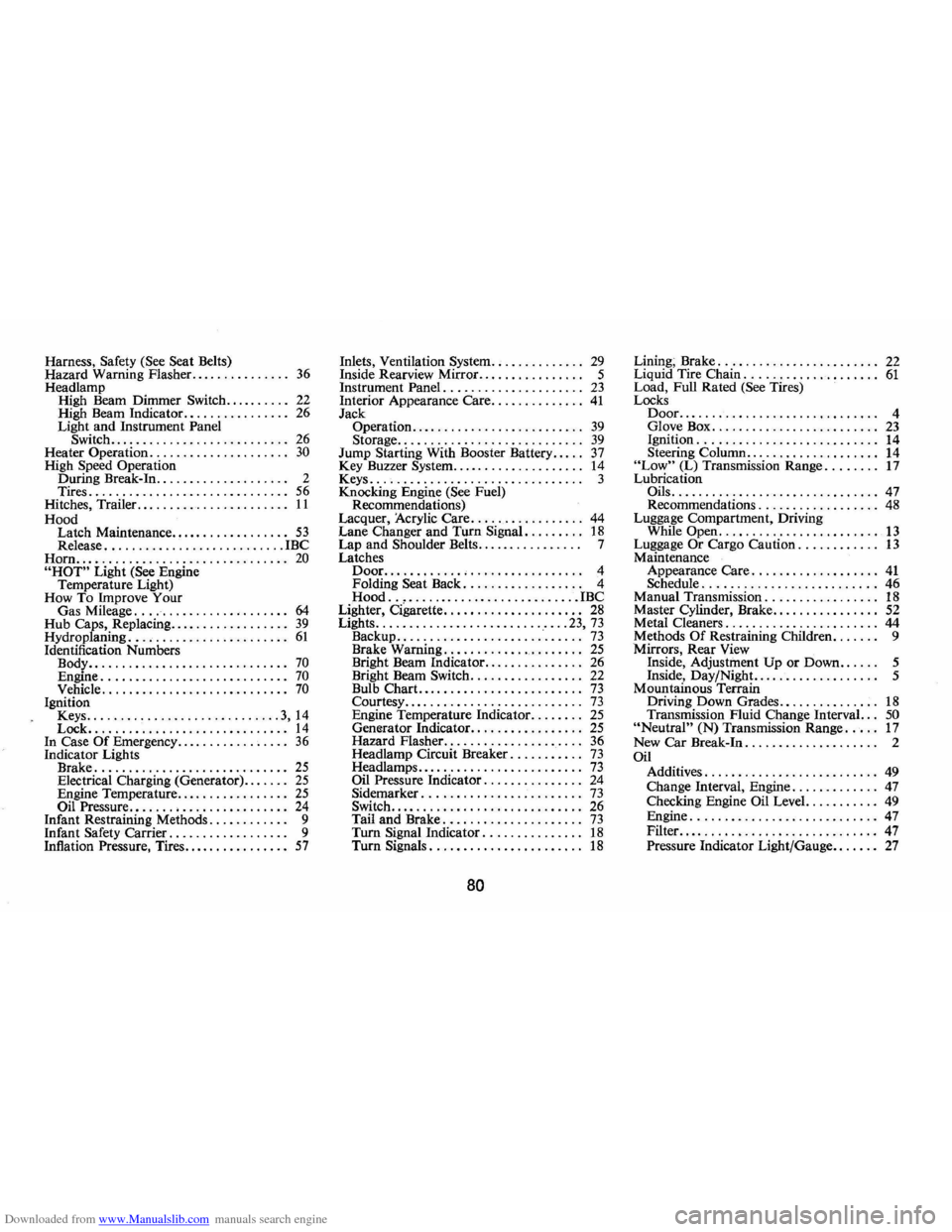1974 CHEVROLET CAMARO oil additives
[x] Cancel search: oil additivesPage 52 of 85

Downloaded from www.Manualslib.com manuals search engine Checking Oil Level
The engine oil should be main
tained at proper level. The best
time to check it
is before operating
the engine or
as the last step in a
fuel stop. This will allow the oil ac
cumulation in the engine to drain
back in the crankcase.
To check
the level, remove the oil guage rod
(dip stick), wipe it clean and rein
sert
it firmly for an accurate read
ing. The oil gauge rod
is marked
"FULL" and "ADD." The oil level
should be maintained in the safety
margin, neither going above the
"FULL" line nor below the "ADD"
line. Reseat the gauge firmly after
taking the reading.
Supplemental Engine Oil
Additives
The regular use of supplemental
additives
is specifically not recom
mended and will increase operat
ing costs. However, supplemental additives
are available that can
effectively and economically solve
certain specific problems without
causing other difficulties.
For ex
ample, if higher detergency
is re
quired to reduce varnish and
sludge deposits resulting from
some unusual operational diffi
culty, a thoroughly tested and ap
proved additive -
"Super Engine
Oil Supplement" -is available at
your Chevrolet dealer.
In the event
of an operational problem, consult
your dealer for advice before
us
ing supplemental additives.
Drive Belts
Every 6,000 miles or 4 months
inspect drive belts for wear , fray
ing, cracking , and tension. Belts
which are in poor condition should
be replaced immediately.
Check tension by applying mod
erate thumb pressure midway be
tween pulleys.
If the center-to-
49
center distance between pulleys is
13 to 16 inches, the belt should
deflect
1;2 inch . If the center-to
center distance
is 7 to 10 inches,
the belt should deflect
1;4 inch.
Loose belts should be retensioned
to give the correct deflection.
It is recommended that belts be
replaced every 24 months or
24,000
miles , whichever occurs first.
Air Cleaner
CAUTIOH:Donot remo.vElfhe f1ngl,,~ al,. cleaner unlesstempo,ary removall$.nec~ essarrdur;ng repair ormaintenal1ce ot the vehicle; When t"ealrC/f1aneri$/~emoved backtlringcan cause tire in the engine
compartment. .',' . '
Flame Arrester -Every 12,000
miles-Clean the arrester (located
in the base of the air cleaner) with
kerosene or a suitable solvent. Dry
with compressed air.
Rear Axle
Standard -Every 4 months or
6,000 miles, whichever occurs
Page 57 of 85

Downloaded from www.Manualslib.com manuals search engine tory with a high-quality, inhibited,
year-around coolant that meets the
standards of General Motors
Spe
cification 1899-M. This coolant
solution provides freezing protec
tion to
-20oP (-35°P in Can
ada), and it has been formulated to
be used for two full calendar years
or
24,000 miles, whichever first
occurs, of normal operation with
out replacement, provided the
proper concentration of coolant is
maintained.
Cooling System Care
The radiator cap should not be
removed to check coolant level.
Check the coolant level visually in
the 'see thru' coolant recovery tank
at least
as frequently as engine oil
changes. Level should be at the
"full cold" mark on the recovery
tank when the system
is cold. At
normal operating temperature the
coolant should be at the
"full hot"
mark on the recovery tank. Add sufficient
coolant to the recovery
tank.
Use a 50/50 mixture of high
quality ethylene glycol antifreeze
and water for coolant additions.
If
regular additions are required, see
your dealer for a cooling system
check.
NOTE: If recommended quality
antifreeze
is used, supplemental in
hibitors or additives claiming to
provide increased capability are
not necessary. They may be detri
mental to the efficient operation of
the system, and represent an un
necessary operating expense.
Every year, the cooling system
should be serviced
as follows:
1. Wash
radiator cap and filler
neck with clean water.
2. Check coolant for proper level
and freeze protection.
3. Pressure test system and radia-
54
tor cap for proper pressure hold
ing capacity (15 psi) .
If re
placement of cap
is required, use
the special AC cap designed for
coolant recovery systems, speci
fied for your model.
4. Tighten hose clamps and inspect
all hoses. Replace hoses when
ever swollen, checked or other
wise deteriorated.
5. Clean frontal area of radiator
core and air conditioning con
denser.
Replace hoses every 24 months
or 24,000 miles or earlier if
checked, swollen or otherwise de
teriorated. Every two years
or 24,-
000 miles, whichever first occurs,
the cooling system should be
flushed and refilled using the fol
lowing recommended procedure:
1. Remove radiator cap when
engine is cool by:
• Slowly rotating cap counter-
Page 83 of 85

Downloaded from www.Manualslib.com manuals search engine Harness, Safety (See Seat Belts) Hazard VVarning Flasher ............... 36 Headlamp
High Beam Dimmer Switch .......... 22
High Beam Indicator ................ 26
Light and Instrument Panel
Switch ........................... 26
Heater Operation ..................... 30 High Speed Operation
During Break-In.. . . . . . . . . . . . . . . . . . . 2 Tires .............................. 56 Hitches, Trailer... . . . . . . . . . . . . . . . . . . .. 11 Hood Latch Maintenance.. . . . . . . . . . . . . . . .. 53 Release ........................... IBC Horn ................................ 20 "HOT" Light (See Engine
Temperature Light)
How To Improve Your Gas Mileage. . . ... . . . . . . . . . . . . . . . . .. 64 Hub Caps, Replacing.. . . . . . . . . . . . . . . .. 39 Hydroplaning. . . . . . . . . . . . . . . . . . . . . . .. 61 Identification Numbers
Body .............................. 70 Engine ............................ 70 Vehicle ............................ 70 Ignition Keys ............................. 3,14 Lock .............................. 14 In Case Of Emergency ............ , . . .. 36 Indicator Lights
Brake ............................. 25 Electrical Charging (Generator) ....... 25 Engine Temperature. . . . . . . . . . . . . . . .. 25 Oil Pressure .......•................ 24
Infant Restraining Methods. . . . . . . . . . .. 9
Infant Safety Carrier. . . . . . . . . . . . . . . . .. 9
Inflation Pressure, Tires..... . . . . . . . . . .. 57 Inlets,
Ventilation
System .............. 29
Inside Rearview Mirror.. . . . . . . . . . . . . . . 5 Instrument Panel. . . . . . . . . . . . . . . . . . . .. 23 Interior Appearance Care .............. 41 Jack Operation .......................... 39 Storage ............................ 39 Jump Starting VVith Booster Battery ..... 37 Key Buzzer System .................... 14 Keys................................ 3 Knocking Engine (See Fuel)
Recommendations)
Lacquer,
J\crylic Care ................. 44 Lane Changer and Turn Signal. . . . . . . .. 18 Lap and Shoulder Belts...... .. .. .... .. 7 Latches Door.............................. 4 Folding Seat Back. . . . . . . . . . .. . . . . .. 4 Hood ............................. IBC
Lighter, Cigarette ....•................ 28
Lights ............................. 23,73 Backup ............................. 73 Brake VVarning ..................... 25 Bright Beam Indicator ............... 26
Bright Beam Switch ................. 22
Bulb Chart. ........................ 73 Courtesy ........................... 73 Engine Temperature Indicator. . . . . . .. 25 Generator Indicator ................. 25 Hazard Flasher.. . . . . . . . . . . . .. . . . . .. 36 Headlamp Circuit Breaker. . . . . . . . . .. 73 Headlamps. . . . . . . . . . . . . . . . . . . . . . . .. 73 Oil Pressure Indicator. . . . . . . . . . . . . .. 24
Sidemarker. . . . . . . . . . . . . . . . . . . . . . .. 73 Switch ............................. 26
Tail and Brake. . . . . .. . . . . . . . . . . . ... 73 Turn Signal Indicator ............... 18 Turn Signals. . . . . . . . . . . . . . . . . . . . . .. 18
80
Lining; Brake. . . . . . . . . . . . . . . . . . . . . . .. 22
Liquid Tire Chain. . . . . . . . . . . . . . . . . . .. 61 Load, Full Rated (See Tires)
Locks
Door.............................. 4 Glove Box. . . . . . . . . . . . . . . . . . . . . . . .. 23
Ignition ........................... 14 Steering Column .................... 14 "Low" (L) Transmission Range. . . . . . .. 17 Lubrication Oils ............................... 47
Recommendations. . . . . . . . . . . . . . . . .. 48
Luggage Compartment, Driving
VVhile Open ........................ 13 Luggage Or Cargo Caution. . . . . . . . . . .. 13
Maintenance
Appearance
Care. . . . . . . . . . . . . . . . . .. 41 Schedule. . . . . . . . . . . . . . . . . . . . . . . . .. 46 Manual Transmission. . . . . . . . . . . . . . . .. 18
Master Cylinder, Brake ................ 52
Metal Cleaners. . . . . . . . . . . . . . . . . . . . . .. 44
Methods Of Restraining Children. .... .. 9
Mirrors, Rear View
Inside, Adjustment Up or Down.... .. 5 Inside, Day/Night.... . . . ... . . . . . . . .. 5 Mountainous Terrain
Driving Down Grades ............... 18
Transmission Fluid Change Interval. " 50 "Neutral" (N) Transmission Range ..... 17 New Car Break-In.................... 2 Oil Additives. . . . . . . . . . . . . . . . . . . . . . . . .. 49
Change Interval, Engine ............. 47
Checking Engine Oil Level. . . . . . . . . .. 49
Engine ............................ 47
Filter .............................. 47 Pressure Indicator Light/Gauge. . . . . .. 27